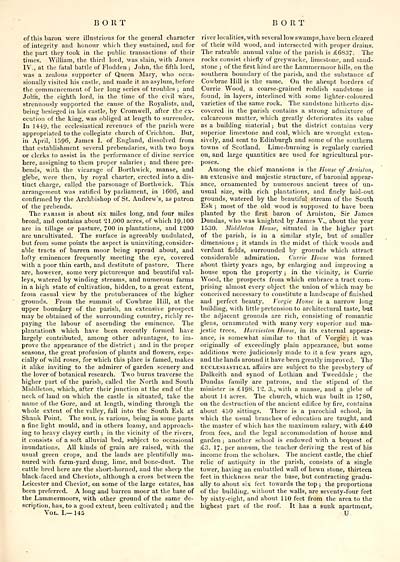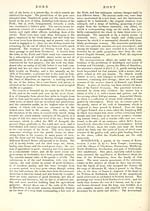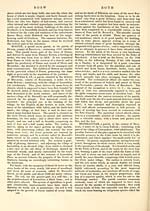Topographical dictionary of Scotland > Volume 1
(159) Page 145
Download files
Complete book:
Individual page:
Thumbnail gallery: Grid view | List view

B O It T
BORT
of this baron were illustrious for the general character
of integrity and honour which they sustained, and for
the part they took in the public transactions of their
times. William, the third lord, was slain, with James
IV., at trie fatal battle of Flodden ; John, the fifth lord,
was a zealous supporter of Queen Mary, who occa-
sionally visited his castle, and made it an asylum, before
the commencement of her long series of troubles ; and
John, the eighth lord, in the time of the civil wars,
strenuously supported the cause of the Royalists, and,
being besieged in his castle, by Cromwell, after the ex-
ecution of the king, was obliged at length to surrender.
In 1449, the ecclesiastical revenues of the parish were
appropriated to the collegiate church of Crichton. But,
in April, 1596, James I. of England, dissolved from
that establishment several prebendaries, with two boys
or clerks to assist in the performance of divine service
here, assigning to them proper salaries ; and these pre-
bends, with the vicarage of Borthwick, manse, and
glebe, were then, by royal charter, erected into a dis-
tinct charge, called the parsonage of Borthwick. This
arrangement was ratified by parliament, in 1606, and
confirmed by the Archbishop of St. Andrew's, as patron
of the prebends.
The parish is about six miles long, and four miles
broad, and contains about 21,000 acres, of which 19,100
are in tillage or pasture, 700 in plantations, and 1200
are uncultivated. The surface is agreeably undulated,
but from some points the aspect is uninviting, consider-
able tracts of barren moor being spread about, and
lofty eminences frequently meeting the eye, covered
with a poor thin earth, and destitute of pasture. There
are, however, some very picturesque and beautiful val-
leys, watered by winding streams, and numerous farms
in a high state of cultivation, hidden, to a great extent,
from casual view by the protuberances of the higher
grounds. From the summit of Cowbrae Hill, at the
upper boundary of the parish, an extensive prospect
may be obtained of the surrounding country, richly re-
paying the labour of ascending the eminence. The
plantations which have been recently formed have
largely contributed, among other advantages, to im-
prove the appearance of the district ; and in the proper
seasons, the great profusion of plants and flowers, espe-
cially of wild roses, for which this place is famed, makes
it alike inviting to the admirer of garden scenery and
the lover of botanical research. Two burns traverse the
higher part of the parish, called the North and South
Middleton, which, after their junction at the end of the
neck of land on which the castle is situated, take the
name of the Gore, and at length, winding through the
whole extent of the valley, fall into the South Esk at
Shank Point. The soil is various, being in some parts
a fine light mould, and in others loamy, and approach-
ing to heavy clayey earth ; in the vicinity of the rivers,
it consists of a soft alluvial bed, subject to occasional
inundations. All kinds of grain are raised, with the
usual green crops, and the lands are plentifully ma-
nured with farm-yard dung, lime, and bone-dust. The
cattle bred here are the short-horned, and the sheep the
black-faced and Cheviots, although a cross between the
Leicester and Cheviot, on some of the large estates, has
been preferred. A long and barren moor at the base of
the Lammermoors, with other ground of the same de-
scription, has, to a good extent, been cultivated ; and the
Vol. I.— 145
river localities, with several low swamps, have been cleared
of their wild wood, and intersected with proper drains.
The rateable annual value of the parish is £6837. The
rocks consist chiefly of greywacke, limestone, and sand-
stone ; of the first kind are the Lammermoor hills, on the
southern boundary of the parish, and the substance of
Cowbrae Hill is the same. On the abrupt borders of
Currie Wood, a coarse-grained reddish sandstone is
found, in layers, interlined with some lighter- coloured
varieties of the same rock. The sandstone hitherto dis-
covered in the parish contains a strong admixture of
calcareous matter, which greatly deteriorates its value
as a building material ; but the district contains very
superior limestone and coal, which are wrought exten-
sively, and sent to Edinburgh and some of the southern
towns of Scotland. Lime-burning is regularly carried
on, and large quantities are used for agricultural pur-
poses.
Among the chief mansions is the House of Arniston,
an extensive and majestic structure, of baronial appear-
ance, ornamented by numerous ancient trees of un-
usual size, with rich plantations, and finely laid-out
grounds, watered by the beautiful stream of the South
Esk ; most of the old wood is supposed to have been
planted by the first baron of Arniston, Sir James
Dundas, who was knighted by James V., about the year
1530. Middleton House, situated in the higher part
of the parish, is in a similar style, but of smaller
dimensions ; it stands in the midst of thick woods and
verdant fields, surrounded by grounds which attract
considerable admiration. Currie House was formed
about thirty years ago, by enlarging and improving a
house upon the property ; in the vicinity, is Currie
Wood, the prospects from which embrace a tract com-
prising almost every object the union of which may be
conceived necessary to constitute a landscape of finished
and perfect beauty. Vorgie House is a narrow long
building, with little pretension to architectural taste, but
the adjacent grounds are rich, consisting of romantic
glens, ornamented with many very superior and ma-
jestic trees. Harvieston House, in its external appear-
ance, is somewhat similar to that of Vorgie; it was
originally of exceedingly plain appearance, but some
additions were judiciously made to it a few years ago,
and the lands around it have been greatly improved. The
ecclesiastical affairs are subject to the presbytery of
Dalkeith and synod of Lothian and Tweeddale ; the
Dundas family are pati-ons, and the stipend of the
minister is £19S. 12. 3., with a manse, and a glebe of
about 14 acres. The church, which was built in 1780,
on the destruction of the ancient edifice by fire, contains
about 450 sittings. There is a parochial school, in
which the usual branches of education are taught, and
the master of which has the maximum salary, with £40
from fees, and the legal accommodation of house and
garden ; another school is endowed with a bequest of
£3. 17. per annum, the teacher deriving the rest of his
income from the scholars. The ancient castle, the chief
relic of antiquity in the parish, consists of a single
tower, having an embattled wall of hewn stone, thirteen
feet in thickness near the base, but contracting gradu-
ally to about six feet towards the top ; the proportions
of the building, without the walls, are seventy-four feet
by sixty-eight, and about 110 feet from the area to the
highest part of the roof. It has a sunk apartment,
U
BORT
of this baron were illustrious for the general character
of integrity and honour which they sustained, and for
the part they took in the public transactions of their
times. William, the third lord, was slain, with James
IV., at trie fatal battle of Flodden ; John, the fifth lord,
was a zealous supporter of Queen Mary, who occa-
sionally visited his castle, and made it an asylum, before
the commencement of her long series of troubles ; and
John, the eighth lord, in the time of the civil wars,
strenuously supported the cause of the Royalists, and,
being besieged in his castle, by Cromwell, after the ex-
ecution of the king, was obliged at length to surrender.
In 1449, the ecclesiastical revenues of the parish were
appropriated to the collegiate church of Crichton. But,
in April, 1596, James I. of England, dissolved from
that establishment several prebendaries, with two boys
or clerks to assist in the performance of divine service
here, assigning to them proper salaries ; and these pre-
bends, with the vicarage of Borthwick, manse, and
glebe, were then, by royal charter, erected into a dis-
tinct charge, called the parsonage of Borthwick. This
arrangement was ratified by parliament, in 1606, and
confirmed by the Archbishop of St. Andrew's, as patron
of the prebends.
The parish is about six miles long, and four miles
broad, and contains about 21,000 acres, of which 19,100
are in tillage or pasture, 700 in plantations, and 1200
are uncultivated. The surface is agreeably undulated,
but from some points the aspect is uninviting, consider-
able tracts of barren moor being spread about, and
lofty eminences frequently meeting the eye, covered
with a poor thin earth, and destitute of pasture. There
are, however, some very picturesque and beautiful val-
leys, watered by winding streams, and numerous farms
in a high state of cultivation, hidden, to a great extent,
from casual view by the protuberances of the higher
grounds. From the summit of Cowbrae Hill, at the
upper boundary of the parish, an extensive prospect
may be obtained of the surrounding country, richly re-
paying the labour of ascending the eminence. The
plantations which have been recently formed have
largely contributed, among other advantages, to im-
prove the appearance of the district ; and in the proper
seasons, the great profusion of plants and flowers, espe-
cially of wild roses, for which this place is famed, makes
it alike inviting to the admirer of garden scenery and
the lover of botanical research. Two burns traverse the
higher part of the parish, called the North and South
Middleton, which, after their junction at the end of the
neck of land on which the castle is situated, take the
name of the Gore, and at length, winding through the
whole extent of the valley, fall into the South Esk at
Shank Point. The soil is various, being in some parts
a fine light mould, and in others loamy, and approach-
ing to heavy clayey earth ; in the vicinity of the rivers,
it consists of a soft alluvial bed, subject to occasional
inundations. All kinds of grain are raised, with the
usual green crops, and the lands are plentifully ma-
nured with farm-yard dung, lime, and bone-dust. The
cattle bred here are the short-horned, and the sheep the
black-faced and Cheviots, although a cross between the
Leicester and Cheviot, on some of the large estates, has
been preferred. A long and barren moor at the base of
the Lammermoors, with other ground of the same de-
scription, has, to a good extent, been cultivated ; and the
Vol. I.— 145
river localities, with several low swamps, have been cleared
of their wild wood, and intersected with proper drains.
The rateable annual value of the parish is £6837. The
rocks consist chiefly of greywacke, limestone, and sand-
stone ; of the first kind are the Lammermoor hills, on the
southern boundary of the parish, and the substance of
Cowbrae Hill is the same. On the abrupt borders of
Currie Wood, a coarse-grained reddish sandstone is
found, in layers, interlined with some lighter- coloured
varieties of the same rock. The sandstone hitherto dis-
covered in the parish contains a strong admixture of
calcareous matter, which greatly deteriorates its value
as a building material ; but the district contains very
superior limestone and coal, which are wrought exten-
sively, and sent to Edinburgh and some of the southern
towns of Scotland. Lime-burning is regularly carried
on, and large quantities are used for agricultural pur-
poses.
Among the chief mansions is the House of Arniston,
an extensive and majestic structure, of baronial appear-
ance, ornamented by numerous ancient trees of un-
usual size, with rich plantations, and finely laid-out
grounds, watered by the beautiful stream of the South
Esk ; most of the old wood is supposed to have been
planted by the first baron of Arniston, Sir James
Dundas, who was knighted by James V., about the year
1530. Middleton House, situated in the higher part
of the parish, is in a similar style, but of smaller
dimensions ; it stands in the midst of thick woods and
verdant fields, surrounded by grounds which attract
considerable admiration. Currie House was formed
about thirty years ago, by enlarging and improving a
house upon the property ; in the vicinity, is Currie
Wood, the prospects from which embrace a tract com-
prising almost every object the union of which may be
conceived necessary to constitute a landscape of finished
and perfect beauty. Vorgie House is a narrow long
building, with little pretension to architectural taste, but
the adjacent grounds are rich, consisting of romantic
glens, ornamented with many very superior and ma-
jestic trees. Harvieston House, in its external appear-
ance, is somewhat similar to that of Vorgie; it was
originally of exceedingly plain appearance, but some
additions were judiciously made to it a few years ago,
and the lands around it have been greatly improved. The
ecclesiastical affairs are subject to the presbytery of
Dalkeith and synod of Lothian and Tweeddale ; the
Dundas family are pati-ons, and the stipend of the
minister is £19S. 12. 3., with a manse, and a glebe of
about 14 acres. The church, which was built in 1780,
on the destruction of the ancient edifice by fire, contains
about 450 sittings. There is a parochial school, in
which the usual branches of education are taught, and
the master of which has the maximum salary, with £40
from fees, and the legal accommodation of house and
garden ; another school is endowed with a bequest of
£3. 17. per annum, the teacher deriving the rest of his
income from the scholars. The ancient castle, the chief
relic of antiquity in the parish, consists of a single
tower, having an embattled wall of hewn stone, thirteen
feet in thickness near the base, but contracting gradu-
ally to about six feet towards the top ; the proportions
of the building, without the walls, are seventy-four feet
by sixty-eight, and about 110 feet from the area to the
highest part of the roof. It has a sunk apartment,
U
Set display mode to: Large image | Transcription
Images and transcriptions on this page, including medium image downloads, may be used under the Creative Commons Attribution 4.0 International Licence unless otherwise stated. ![]()
| Gazetteers of Scotland, 1803-1901 > Topographical dictionary of Scotland > Volume 1 > (159) Page 145 |
|---|
| Permanent URL | https://digital.nls.uk/97483942 |
|---|
| Description | Volume I: From Abbey to Jura. |
|---|---|
| Attribution and copyright: |
|

